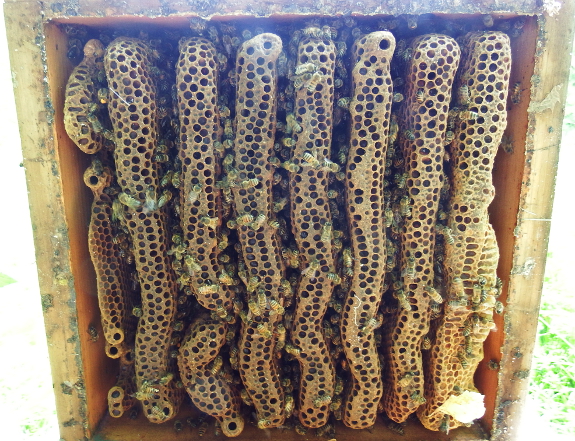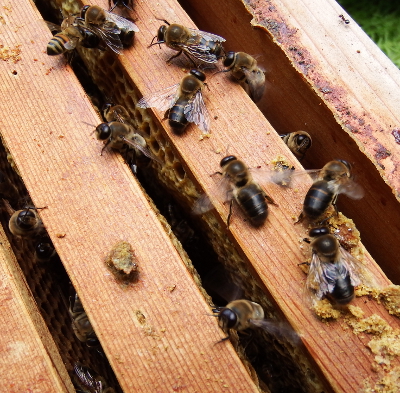
Swarmed out

I hate to admit it, but I
got a bit disheartened by our bees and ignored them for a solid month.
The thing is, I actually lost track of how many swarms materialized and then flew away, never to be seen again. (Four, I think?) It was
pretty amazing when I was watching Artemesia and family graze in the
oats and a mass of bees came flying just over our heads, a few landing
on the trailer roof before leaping back into the air. But my rational
side knows that each absent swarm is that much less chance of homegrown
honey this year.
I seem to use lots of
20/20 hindsight with the bees, but here's a little more. When I opened
up our swarming hive in April, I saw lots of queen cells at the bottom
of the warre box. I cut off one...then got all worried. If the old
matriarch left and I removed all the queen cells, will the new hive
perish? So I left the rest in place. As you can see in the image above,
though, there were many more queen cells than were really necessary, the
likely source of so many afterswarms.
The other hive did
swarm too, though. That one had fewer queen cells in it (two or three, I
think), probably because there wasn't the gap between warre and
langstroth boxes that my converter top created. Honestly, I think that
feeding warre hives in the spring just makes them swarm. So if I want to
bulk up the hives early in search of honey, I need to hurry up and get
those bees back into langstroth boxes so I can checkerboard and use other swarm prevention techniques. (Warre frames just aren't movable enough to use techniques like this with success.)
 On
the plus side, the hive that swarmed several times has capped brood and
is bringing in lots of pollen. So, fingers crossed that their new queen
will finally start laying eggs in the langstroth boxes and I can remove
the warre box to complete the conversaion. The other hive swarmed a bit
later and is all warre (so harder to tell what's going on inside). But
they've got a good bit of honey and will hopefully have new workers soon.
On
the plus side, the hive that swarmed several times has capped brood and
is bringing in lots of pollen. So, fingers crossed that their new queen
will finally start laying eggs in the langstroth boxes and I can remove
the warre box to complete the conversaion. The other hive swarmed a bit
later and is all warre (so harder to tell what's going on inside). But
they've got a good bit of honey and will hopefully have new workers soon.
And, all things
considered, I don't regret being so engrossed in Artemesia's kidding and
in the twins' early childhood that I missed a heaping handful of
swarms. If I could go back in time, even knowing what I know now, I'd do
it all over again. But maybe next year the two events won't coincide
and I'll be a little smarter about early spring bee management. And, who
knows, it could still be such a good nectar year that we get honey.
Hope springs eternal....
Want more in-depth information? Browse through our books.
Or explore more posts by date or by subject.
About us: Anna Hess and Mark Hamilton spent over a decade living self-sufficiently in the mountains of Virginia before moving north to start over from scratch in the foothills of Ohio. They've experimented with permaculture, no-till gardening, trailersteading, home-based microbusinesses and much more, writing about their adventures in both blogs and books.
Want to be notified when new comments are posted on this page? Click on the RSS button after you add a comment to subscribe to the comment feed, or simply check the box beside "email replies to me" while writing your comment.

I think you will be much happier and in more control with the Langstroth hives. They are not currently 'in fashion' but they are historically the way to go.
Remember, swarming is a function of a vibrant colony of bees. You're doing something right! My mentors feel the colony's decision to swarm is made in the previous year and the 'event' just happens in the spring/summer of the following year. Message: if they have decided to swarm there really isn't much you can do to stop them.
You can split them and do the 'swarming' for them though. If you don't want more hives, split them then put them back together a little later on. It takes time and persistence.
There is still plenty of time to get the hive right and ready for honey. Never give up!